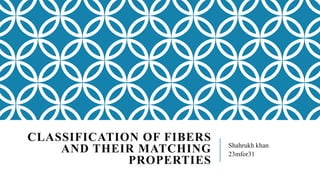
Classification of fibers and their matching properties.pptx
- 1. CLASSIFICATION OF FIBERS AND THEIR MATCHING PROPERTIES Shahrukh khan 23mfor31
- 2. Fibers are long, slender, and often thread-like structures that can be composed of various materials, such as biological tissues, dietary carbohydrates, glass or plastic in optical communication, or other substances, depending on the situation. WHAT IS FIBERS .?
- 3. CLASSIFICATION OF FIBERS 1. Natural fibers 2. Artificial fibers Semi-synthetic fibers Cellulose regenerated fibers 3. Synthetic fibers 1. Metallic fibers 2. Carbon fiber 3. Silicon carbide fiber 4. Fiberglass 5. Mineral fibers 6. Polymer fibers 7. Microfibers
- 4. 1.NATURAL FIBERS •Plant-Based Fibers: Derived from plants, such as cotton, flax (linen), hemp, and jute. •Animal-Based Fibers: Obtained from animals, such as wool (from sheep), silk (from silkworms), and mohair (from goats).
- 5. 2. ARTIFICIAL FIBERS Semi-synthetic fibers Semi-synthetic fibers are made from raw materials with naturally long- chain polymer structure and are only modified and partially degraded by chemical processes, in contrast to completely synthetic fibers such as nylon (polyamide) or dacron (polyester), Cellulose regenerated fibers Cellulose fibers are a subset of artificial fibers, regenerated from natural cellulose. The cellulose comes from various sources: rayon from tree wood fiber, bamboo fiber from bamboo, seacell from seaweed, etc. example •rayon •Lyocell, a brand of rayon •Modal •diacetate fiber •triacetate fiber.
- 6. SYNTHETIC FIBERS Synthetic fiber are made completely of synthetic components such as oil and gas, as compared to natural fibers such as cellulose or protein Carbon fibers frequently originate from oxidized and carbonized polymers such as PAN, but the ultimate product is nearly pure carbon. Metallic fibers can be drawn from soft metals like copper, gold, or silver, as well as ejected or plated from brittle metals like nickel, aluminum, or iron. Silicon carbide fibers, in which the basic polymers are not hydrocarbons but polymers in which approximately 50% of the carbon atoms are replaced by silicon atoms, are known as poly-carbo-silanes. Fiberglass, which is formed of particular glass, and optical fiber, which is composed of enhanced natural quartz,
- 7. CONTINUE.. Mineral fibers can be particularly strong because they are formed with a low number of surface defects; asbestos is a common one. Polymer fibers are a subset of artificial fibers, which are based on synthetic chemicals (often from petrochemical sources) rather than arising from natural materials by a purely physical process. •polyamide nylon •PET or PBT polyester •phenol-formaldehyde (PF) •polyvinyl chloride fiber (PVC) vinyon •polyolefins (PP and PE) olefin fibe Microfibers, Invented in Japan in the early 1980s, microfibers are also known as microdenier fibers. Acrylic, nylon, polyester, lyocell and rayon can be produced as microfibers.
- 8. MATCHING PROPERTIES OF FIBERS In forensic science, the choice of fibers for analysis and comparison is crucial in solving crimes and providing valuable evidence. The properties of fibers play a significant role in this field. 1.Colour: Fiber color can be compared to known samples to identify potential matches. 2 Microscopic Structure:Forensic examiners use microscopes to analyze the microscopic characteristics of fibers, such as cross-sectional shape, surface features, and internal structures, to identify similarities between questioned and known fibers. 3.Chemical Composition:Analyzing the chemical composition of fibers through techniques like infrared spectroscopy or mass spectrometry can help identify matches or differences between fibers. 4. Fiber Diameter:Measuring the diameter of fibers can provide information for comparison, as fibers from different sources may have distinct diameter ranges. 5. Fiber Type (e.g., natural or synthetic):Determining whether a fiber is natural or synthetic can narrow down its potential source. For example, identifying synthetic fibers in a crime scene could lead investigators to a particular brand or manufacturer.
- 9. CONTINUE.. 6. Fiber Length: The length of fibers can vary significantly between different sources, and matching fiber lengths can be valuable evidence. 7. Melting Point (for synthetic fibers):Synthetic fibers have distinct melting points, which can help identify them and potentially link them to specific items or sources. 8. Individualizing Characteristics:In some cases, fibers may have unique characteristics, such as unusual dye patterns or defects, which can be used to establish a specific match. 9. Environmental Considerations:Fibers collected from a crime scene may carry environmental clues, such as pollen, soil particles, or other substances, that can be used for geographical or temporal matching. 10. Transfer and Persistence:Understanding how fibers can transfer from one location to another, and their persistence on clothing or surfaces, helps forensic scientists reconstruct events and establish potential contact between individuals and objects.
- 10. REFERENCES 1. Harper, Douglas. "fiber". Online Etymology Dictionary. 2.^ Jump up to:a b Kadolph, Sara (2002). Textiles. Prentice Hall. ISBN 978-0-13- 025443-6. 3.^ Saad, Mohamed (Oct 1994). Low resolution structure and packing investigations of collagen crystalline domains in tendon using Synchrotron Radiation X-rays, Structure factors determination, evaluation of Isomorphous Replacement methods and other modeling. PhD Thesis, Université Joseph Fourier Grenoble I. pp. 1– 221. doi:10.13140/2.1.4776.7844. 4.^ "man-made fibre". Encyclopædia Britannica. Encyclopædia Britannica, Inc. 2013.